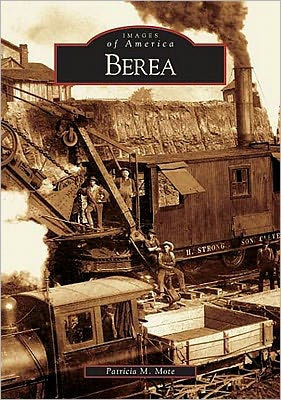Berea
Quarrying was a major industry from roughly 1850 to 1950 in
Berea, attracting large numbers of immigrants in search of work.
Baldwin Institute and University (1846) and German Wallace College (1863) created an academic atmosphere, and Berea’s citizens became an eclectic and resilient mix of academics, business people, and immigrants. Eventually, quarrying ended, and the downtown business district, the Triangle, was nearly destroyed by fire three times. Each time the determined residents of Berea rebuilt. Today, Berea is a unique Cleveland suburb. Baldwin University and German Wallace College merged, and the south side of town has been devoted to recreation by the Cleveland Metroparks System and the City of Berea. The largest quarry became Coe Lake, a site for fishing, canoeing, art fairs, concerts, and ice-skating. Coffee shops, boutiques, and art galleries now thrive in old livery stables, icehouses, and hardware stores. Many of the grand homes of the 19th century still stand, proudly boasting their bronze “Century Home” plaques.
"1104164100"
Berea, attracting large numbers of immigrants in search of work.
Baldwin Institute and University (1846) and German Wallace College (1863) created an academic atmosphere, and Berea’s citizens became an eclectic and resilient mix of academics, business people, and immigrants. Eventually, quarrying ended, and the downtown business district, the Triangle, was nearly destroyed by fire three times. Each time the determined residents of Berea rebuilt. Today, Berea is a unique Cleveland suburb. Baldwin University and German Wallace College merged, and the south side of town has been devoted to recreation by the Cleveland Metroparks System and the City of Berea. The largest quarry became Coe Lake, a site for fishing, canoeing, art fairs, concerts, and ice-skating. Coffee shops, boutiques, and art galleries now thrive in old livery stables, icehouses, and hardware stores. Many of the grand homes of the 19th century still stand, proudly boasting their bronze “Century Home” plaques.
Berea
Quarrying was a major industry from roughly 1850 to 1950 in
Berea, attracting large numbers of immigrants in search of work.
Baldwin Institute and University (1846) and German Wallace College (1863) created an academic atmosphere, and Berea’s citizens became an eclectic and resilient mix of academics, business people, and immigrants. Eventually, quarrying ended, and the downtown business district, the Triangle, was nearly destroyed by fire three times. Each time the determined residents of Berea rebuilt. Today, Berea is a unique Cleveland suburb. Baldwin University and German Wallace College merged, and the south side of town has been devoted to recreation by the Cleveland Metroparks System and the City of Berea. The largest quarry became Coe Lake, a site for fishing, canoeing, art fairs, concerts, and ice-skating. Coffee shops, boutiques, and art galleries now thrive in old livery stables, icehouses, and hardware stores. Many of the grand homes of the 19th century still stand, proudly boasting their bronze “Century Home” plaques.
Berea, attracting large numbers of immigrants in search of work.
Baldwin Institute and University (1846) and German Wallace College (1863) created an academic atmosphere, and Berea’s citizens became an eclectic and resilient mix of academics, business people, and immigrants. Eventually, quarrying ended, and the downtown business district, the Triangle, was nearly destroyed by fire three times. Each time the determined residents of Berea rebuilt. Today, Berea is a unique Cleveland suburb. Baldwin University and German Wallace College merged, and the south side of town has been devoted to recreation by the Cleveland Metroparks System and the City of Berea. The largest quarry became Coe Lake, a site for fishing, canoeing, art fairs, concerts, and ice-skating. Coffee shops, boutiques, and art galleries now thrive in old livery stables, icehouses, and hardware stores. Many of the grand homes of the 19th century still stand, proudly boasting their bronze “Century Home” plaques.
24.99
In Stock
5
1

Berea
128
Berea
128
24.99
In Stock

Product Details
| ISBN-13: | 9780738533308 |
|---|---|
| Publisher: | Arcadia Publishing SC |
| Publication date: | 11/10/2004 |
| Series: | Images of America Series |
| Pages: | 128 |
| Sales rank: | 1,038,282 |
| Product dimensions: | 6.50(w) x 9.25(h) x 0.31(d) |
About the Author
From the B&N Reads Blog
